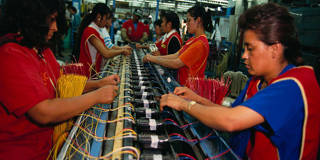Trade and technology present an opportunity when they are able to leverage existing capabilities, and thereby provide a more direct and reliable path to development. When they demand complementary and costly investments, they are no longer a shortcut around traditional manufacturing-led development.
CAMBRIDGE – New technologies reduce the prices of goods and services to which they are applied. They also lead to the creation of new products. Consumers benefit from these improvements, regardless of whether they live in rich or poor countries.
Mobile phones are a clear example of the deep impact of some new technologies. In a clear case of technological leapfrogging, they have given poor people in developing countries access to long-distance communications without the need for costly investments in landlines and other infrastructure. Likewise, mobile banking provided through cell phones has enabled access to financial services in remote areas without bank branches.
These are instances of technology improving the lives of poor people. But for technology to make a real and sustained contribution to development, it must not only provide better and cheaper products; it must also lead to more higher-paying jobs. In other words, it must help poor people in their role as producers as well as consumers. A model of growth that the economist Tyler Cowen has called “cell phones instead of automobile factories” raises the obvious question: How do people in the developing world afford to purchase cell phones in the first place?

CAMBRIDGE – New technologies reduce the prices of goods and services to which they are applied. They also lead to the creation of new products. Consumers benefit from these improvements, regardless of whether they live in rich or poor countries.
Mobile phones are a clear example of the deep impact of some new technologies. In a clear case of technological leapfrogging, they have given poor people in developing countries access to long-distance communications without the need for costly investments in landlines and other infrastructure. Likewise, mobile banking provided through cell phones has enabled access to financial services in remote areas without bank branches.
These are instances of technology improving the lives of poor people. But for technology to make a real and sustained contribution to development, it must not only provide better and cheaper products; it must also lead to more higher-paying jobs. In other words, it must help poor people in their role as producers as well as consumers. A model of growth that the economist Tyler Cowen has called “cell phones instead of automobile factories” raises the obvious question: How do people in the developing world afford to purchase cell phones in the first place?